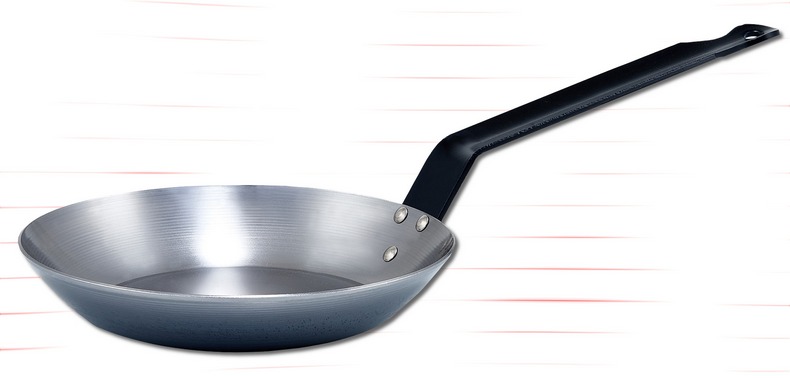Every cooking application gets the best results when you use the right cookware for the job. In our recent blog series, we covered several different types of cookware. All these types of cookware have their own unique benefits. Nonstick makes sautéing, egg cookery, and cleanup easy. Aluminum is desirable for its rapid and even heat conductivity. Stainless steel is durable, easy to clean, and induction ready. But what if there were a type of cookware that combined all these benefits into one? That’s where carbon steel comes in.
What is Carbon Steel?
The composition of carbon steel is about 99% iron and 1% carbon. Compare that to cast iron which has about 97% iron and 3% carbon. It may seem insignificant, but that 2% reduction in carbon makes a big difference. Carbon steel is thinner, lighter, and more pliable than cast iron. At the same time, it is very durable. The extra pliability results in a smoother, more uniform pan surface. Carbon steel skillets are also lighter and easier to handle than cast iron.
What this means for chefs in the kitchen is a very versatile pan. Carbon steel skillets provide quick, even heat distribution with excellent searing capability. They deliver the same slickness and easy cleanup you would expect from nonstick pans. With carbon steel you can sauté, sear, braise, broil, roast, cook eggs, and even bake desserts. You can start recipes on the range top and transfer them straight to the oven to finish. They are also induction ready, so you can use them with an induction range.
Carbon steel skillets are available in different sizes from about 7 to 18 inches in diameter. Most carbon steel skillets feature a thick, solid steel handle either welded or to riveted to the pan. These heavy-duty handles are slow to transfer heat. So unless you are taking the pan out of the oven, there is no need for an insulated pan holder.
Black and Blue
When you shop for carbon steel skillets, you may notice “black steel” or “blue steel” in the description. This refers to different surface hardening treatments. The main purpose of these treatments is to make the pan rust-deterrent. They can cause the pan to have a black or blue-like appearance. Whether black or blue, the color does not make a difference in the performance of the pan, only in appearance.
In Season
Like cast iron, carbon steel requires seasoning. Seasoning is the process of bonding oil to the pan with heat. It provides protection from rust and helps the pan to become more nonstick. Without seasoning, food can stick to the pan, and the pan can rust if left bare or wet.
Many carbon steel skillets ship with a grease or beeswax coating to prevent rust. If this is the case for your skillet, you will need to take a few extra steps the first time you season it. First, scrub off the coating under very hot water and an abrasive scouring pad. Next, dry the pan with a soft cloth or dish towel and place it on the range top over low heat to dry completely. Add 1/3 cup of oil, the peel of two potatoes, and a handful of kosher salt. Cook over medium heat, stirring the contents all around the pan for about 10 minutes. This will remove any remaining shipping grease or beeswax while seasoning the pan. Allow the pan to cool and wipe clean with a cloth or paper towel. Your pan is now seasoned and ready to use.
Maintenance
As you continue to use your carbon steel skillet over time, it will develop a patina. This is both normal and desirable. Each use adds to the seasoning and develops more patina. This patina may look blotchy at first, but the pan surface will continue to darken and look more even over time.
Hand washing is the best method to maintain the seasoning on your carbon steel skillet. Avoid running it through the dishwasher or using harsh detergent. In most cases, all you need to do is rinse the pan under hot water. If the skillet is well seasoned, it should prevent any foodstuff from sticking to it. If there is still some stubborn foodstuff left behind, you can use mild dish soap and a scouring pad to remove it. After rinsing the pan clean, dry the pan with a soft cloth or dish towel. Finally, apply a light coat of oil to the cooking surface and to the outside of the skillet before storing it.
If you happen to remove some of the seasonings, it is very easy to restore it. Apply another light coat of oil to the pan and place it over medium heat on the range top for about 10 minutes. The pan should darken and develop a new patina.
Shop
Carbon steel skillets make a great addition to any chef’s arsenal. Their versatility makes them an excellent choice for almost any cooking application. You can find carbon steel skillets in our store at 3310 Preston Highway in Louisville, KY. You can also click here to find them in our online store. For more information, please call 866-591-3463 to speak to a product specialist.


